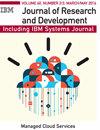Summit和Sierra超级计算机的高速网络
IF 1.3
4区 计算机科学
Q1 Computer Science
引用次数: 14
摘要
橡树岭国家实验室的Summit超级计算机和劳伦斯利弗莫尔国家实验室的Sierra超级计算机在Fat-tree网络拓扑中利用InfiniBand互连,将所有计算节点、存储节点、管理节点互连到一个线性可扩展的网络中。这些网络基于Mellanox 100 gb /s EDR InfiniBand ConnectX-5适配器和Switch-IB2交换机,采用IBM提供的计算机架封装和冷却技术。这些设备支持网络内计算加速引擎,如Mellanox Scalable Hierarchical Aggregation and Reduction Protocol、GPU (graphics processor unit) Direct RDMA、高级自适应路由、Quality of Service等网络和应用加速。整个IBM Spectrum Message Passing Interface (MPI)消息传递软件栈实现了Open MPI,是IBM、Mellanox和NVIDIA之间的合作,用于优化端点之间的直接通信,无论是计算节点(带有IBM POWER cpu、NVIDIA gpu和闪存设备),还是POWER托管的存储节点。Fat-tree网络可以隔离计算分区之间和存储子系统之间的流量,从而提供更可预测的应用程序性能。此外,该网络的高水平冗余及其重新配置能力确保了即使在网络组件发生故障后也能提供可靠的高性能。本文详细介绍了网络的硬件和软件体系结构和性能,并描述了为这一代InfiniBand设计的许多高性能计算(HPC)增强。本文章由计算机程序翻译,如有差异,请以英文原文为准。
The high-speed networks of the Summit and Sierra supercomputers
Oak Ridge National Laboratory's Summit supercomputer and Lawrence Livermore National Laboratory's Sierra supercomputer utilize InfiniBand interconnect in a Fat-tree network topology, interconnecting all compute nodes, storage nodes, administration, and management nodes into one linearly scalable network. These networks are based on Mellanox 100-Gb/s EDR InfiniBand ConnectX-5 adapters and Switch-IB2 switches, with compute-rack packaging and cooling contributions from IBM. These devices support in-network computing acceleration engines such as Mellanox Scalable Hierarchical Aggregation and Reduction Protocol, graphics processor unit (GPU) Direct RDMA, advanced adaptive routing, Quality of Service, and other network and application acceleration. The overall IBM Spectrum Message Passing Interface (MPI) messaging software stack implements Open MPI, and was a collaboration between IBM, Mellanox, and NVIDIA to optimize direct communication between endpoints, whether compute nodes (with IBM POWER CPUs, NVIDIA GPUs, and flash memory devices), or POWER-hosted storage nodes. The Fat-tree network can isolate traffic among the compute partitions and to/from the storage subsystem, providing more predictable application performance. In addition, the high level of redundancy of this network and its reconfiguration capability ensures reliable high performance even after network component failures. This article details the hardware and software architecture and performance of the networks and describes a number of the high-performance computing (HPC) enhancements engineered into this generation of InfiniBand.
求助全文
通过发布文献求助,成功后即可免费获取论文全文。
去求助
来源期刊

IBM Journal of Research and Development
工程技术-计算机:硬件
自引率
0.00%
发文量
0
审稿时长
6-12 weeks
期刊介绍:
The IBM Journal of Research and Development is a peer-reviewed technical journal, published bimonthly, which features the work of authors in the science, technology and engineering of information systems. Papers are written for the worldwide scientific research and development community and knowledgeable professionals.
Submitted papers are welcome from the IBM technical community and from non-IBM authors on topics relevant to the scientific and technical content of the Journal.
 求助内容:
求助内容: 应助结果提醒方式:
应助结果提醒方式:


